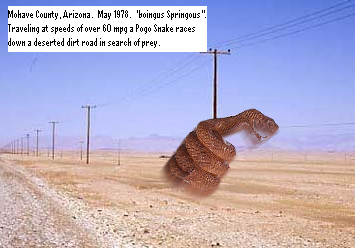Pogosnake
| Pogosnake | |
|---|---|
 | |
| Scientific classification | |
| Kingdom | Animal |
| Phylum | Chordate |
| Class | Reptilian |
| Order | Arizona |
| Family | Snake |
| Genus | Albert Einstein |
| Species | springus |
| Binomial name | |
| Stu | |
| Specifications | |
| Primary armament | Biting |
| Secondary armament | "Spring Choke" |
| Power supply | Long range of sight |
| Health | 15 |
| Mana | 17 |
| Strength | 5 |
| Intelligence | 4 |
| Weight | 6-10 lb. |
| Length | 3-6 ft. |
| Special attack | Can call in cousin Hoop snake |
| Conservation status | |
| Super duper rare | |
Pogosnakes (or Pogo snakes or What the fuck was that?) are a less badass cousin of the deadly Hoop snake, belonging to the class of venomous snakes known commonly as "Bouncy vipers".
Overview[edit]
Found only in Mohave County, Arizona, there are nearly fifty species of Pogosnake, with numerous subspecies. They are named for their bouncy nature and travel in herds. The scientific name Oxyuranus springous derives from the Mohave Indian word, κρόταλον, meaning "bouncy". The name springous is the Hualapai Indian word for "springy" and shares its root with the modern day spring, commonly found in ball point pens and around shock absorbers on vehicles. Most Pogosnakes mate in the spring, and all species give birth to live baby Pogosnakes. Mothers abandon their young within hours after birth, but not to fear - they bounce back.
Reproduction[edit]
Big Pogosnakes give birth to little Pogosnakes. First, two big Pogosnakes have to meet. Singlepogosnakes.com is a popular online dating site for Pogo Snakes. There they can hop from page to page previewing fotos and biographical data of other potential Pogosnake mates. Jewish Pogosnakes, gay Pogosnakes, and straight Pogsnakes can utilize special preference filtering options, if in fact it is possible to have a straight Pogosnake, thereby negating the pogoing effect.
Civil rights of Pogosnakes[edit]
The EEOCP, Equal Employment Opportunity Commission of Pogosnakes, is the de facto Pogosnake rights enforcement organization. Should a Pogosnake face discrimination in the work place, he or she has the option of contacting their local branch of the EEOCP and filing a complaint. Thumbprints are required for identification purposes. Coffee and donuts are served.
Digestion and diet[edit]
All snakes eat meat, and the Pogosnake likes nothing more than his meat. In fact, a Pogosnake can't beat his meat. Every day, a Pogosnake eats its weight in small animals including lizards and other snakes, rodents and other small mammals, birds, eggs, insects, small varmints, BLTs, fossils of animals and alien critters. Some snakes have a venomous bite, which they use to kill their prey before eating it. Other snakes kill their prey by constriction. Still others swallow their prey whole and alive. Pogosnakes use the "chase and trip" method.
Once a Pogosnake spots its prey, it will bounce after the prey and chase it. When the Pogosnake is close enough it will spring itself into the path of the victim and tangle its body among its legs. The ensuing tumbling mass of Pogosnake and varmint will cause a cloud of dust, hooves, weeds, and Pogosnake to go tumbling across the desert ground. When the ball of dust settles, usually the Pogosnake has wrapped its body around the neck of its victim and applies pressure to [Pepsi Cola|pop] its head off. Baby Pogosnakes will often wrap themselves around the wrists of Hualapai Indians and cause "Indian burns". Children do this with their pet Pogosnakes for fun, even though their mothers tell them not to.
After eating, snakes become torpid (full) while the process of digestion takes place. After drinking several beers, Pogosnakes become downright ornery. Many a Pogosnake has been thrown out of a bar after taunting others with "I can jump higher than youuuuu-uuu! I can jump higher than youuuu-uuuu!!!".
Pogosnakes do not normally eat people, but they will prey on them. A Pogosnake will hide in the bushes of a well-marked trail or sidewalk and there it will wait until an unsuspecting Mojave or Hualapai Indian will walk by. Then, at the last second, the Pogosnake will spring out and trip its unsuspecting victim and slither away quickly. The victim will fall to the ground and spin around angrily to see who or how he tripped – but there will be nothing there. Only the giggling from the bushes can clue someone into the perpetrator of the crime.
Perception[edit]
While snake vision has been scientifically determined to be okey-dokey, for the most part a snake's sense of accessorizing is abysmal. Some snakes, like the Pogosnake, have binocular smelling. In addition to their eyes, some snakes have radar (what submarines use) in deep grooves between the nostril and eye which allow them to hear noises. It is thought that the near extinction of the Flatulant Desert Field Mouse is due to the Pogosnake's excellent senses of hearing and smell.